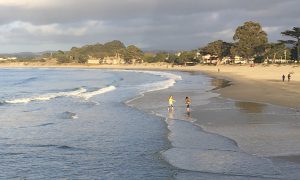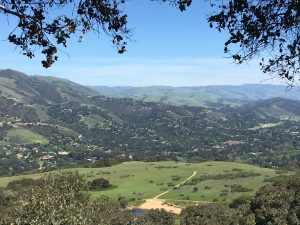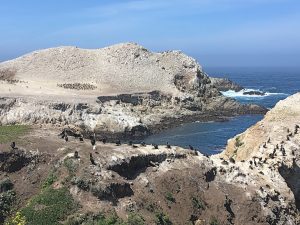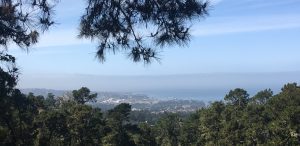10 – 23 April 2018
We have been in Monterey for more than two weeks now. With the exception of half a day here and there the winds and waves haven’t behaved to the captain’s liking, so we’ve stayed put. Two Sundays in a row were ready to leave, and each time there was a last-minute mechanical problem—first a torn fan belt, then a broken throttle shifter. That meant back to the dock and cooling our heels.
I’m not complaining; not at all. On land the weather is great—mostly sunny with a few cool, windy days thrown into the mix. One never quite knows what to wear when heading out for a day in town or country, so I get into the habit of stuffing a warm windbreaker into my daypack. I’m exploring the surrounding areas and meet interesting people—mostly artists and gallery owners during my forays to Carmel-by-the-Sea. One of them, Robin and husband Ron invite me for drinks at the Monterey Peninsula Yacht Club. The next day I get the chance to return the favour by helping remove a damaged mast from their sailboat.
My excursions include cycling the Monterey Bay Coastal Trail to Point Pinos Lighthouse and going to the Sea Otter Classic (touted as the world’s premier cycling festival) at the Laguna Seca race track, ten miles east of town. It is rather mind-boggling seeing the tent city of nearly 500 exhibitors showing off anything from energy drinks to bike clothing, gear, tools and, of course bicycles. On Thursday, the first day of the event, my $20 admission is a bit of a waste as I’m not quite in the market for a new $10,000 bike, and the various races—including slalom, downhill, cross-country and track—wouldn’t get fully underway until the following days.
As much as I use a bicycle for commuting at home, when travelling my preferred modes of transportation are public transit and walking. And so it happens that on a sunny Saturday I take the bus to Carmel Valley. When I ask a fellow passenger what there is to see in this village, he says that the only attraction is a wine tasting tour. But he suggests to stop at nearby Garland Ranch Regional Park to take a look at the Carmel River and perhaps go for a hike on the trails.
The park has an excellent visitor’s centre. The lone attendant gives me some tips and suggests a route that would bring me back to the starting point in a couple of hours. Outfitted with a trail map I’m enjoying my day in nature so much that I go a little further, figuring that I can handle three hours of hiking uphill and down. My favourite is the Waterfall Trail which descends to the bottom of a sheer cliff, though the waterfall itself doesn’t materialize as it only runs seasonally.
Next to the rock face I come upon a young family whose (I estimate) six-year old girl, frightened by a dog, had fallen and hurt her shin. They ask if I have any candy to help ease the pain. Fortunately, there is still some trail nut mix left in my pack and I let them pick out the little chocolate-covered M&M candies. It seems to do the trick, for the sweet medicine stops the tears.
Another art gallery acquaintance, Suzanne, tells me about several parks in the area that I should visit. She is an avid hiker and offers to take me by car to one of her favourites, Point Lobos State Reserve. I welcome the chance to be shown the area by a local. We drive into Carmel, along winding Scenic Drive, past 19th century Mission Ranch, owned by Hollywood legend Clint Eastwood.
In Point Lobos park an old wooden building, looking like a former cabin that may have been used by 19th century sailors, now houses a small whaling museum reflecting the area’s history. From here we begin our hike along the rugged shoreline. Tall pines shelter the path while below several seals and their pups sun themselves on a pocket beach wedged between rock faces. In another bay we observe a couple of sea otters floating belly-up among kelp beds. Toward the southern end of the park the vista opens up with rock formations that must be a geologist’s dream, and indeed there is a group (students?) sitting on the boulders, sketching. Further on we find a large cormorant colony, some of whom are building twig nests on dirt patches and bare rock.
After several hours of walking we drive further south to the rustic Big Sur River Inn for a late lunch. Nestled among redwood trees on the banks of a stream the atmosphere of this 1930s establishment certainly cannot be faulted, but it’s a bit pricey considering the “homesteader” type food. We supplement the simple main menu with tasty onion rings and a chocolate milkshake topped with—what else—real whipped cream and a sprig of mint.
Yet another park on my to-do list is Jacks Peak. It is six miles from the harbour, but without any bus routes leading there, I take to the road the following day on the captain’s bicycle. It’s been three days in a row of hiking, two of them on mountain trails. And while the bike ride seems a welcome exercise change, covering a thousand-foot elevation differential and walking a short couple of miles of forest trails makes me vow to give my poor muscles a break tomorrow.
___________
Photos: 1.) Monterey Municipal Beach; 2.) vendors avenue at the Sea Otter Classic bicycle festival; 3.) view of Carmel Valley from Garland Ranch Regional Park; 4.) Point Lobos park trail; 5.) cormorant colony; 6.) Bixby Bridge crossing the canyon and creek of the same name on the way to Big Sur; 7.) view of Monterey harbour from Jacks Peak County Park.







